文章
Dummer. ゛☀
2017年08月08日

By Mary H. Dyer, Master Naturalist and Master Gardener What is clubroot? This difficult disease is caused by a soilborne fungus that affects cruciferous vegetables like: Broccoli Cauliflower Cabbage Turnips Mustard Clubroot is particularly nasty because it can live in the soil for as long as seven to 10 years, making the area unfit for growing susceptible plants. Symptoms of Clubroot The primary symptoms of clubroot include enlarged, deformed, club-shaped roots and stunted growth. Eventually, the swollen roots turn black and develop a rotten aroma. In some cases, the disease may cause wilted, yellowing or purple foliage, although the disease isn’t always apparent above the ground.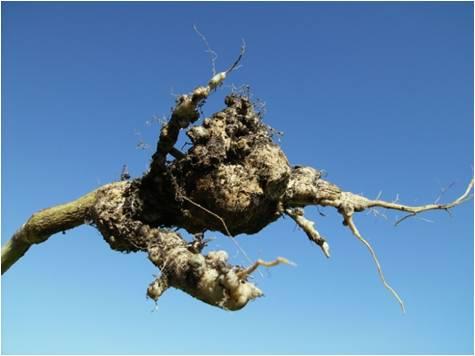
Clubroot Control Clubroot is extremely difficult to manage and the best way to control its spread is to rotate crops, which means not planting cruciferous plants in the same area more than once every three or four years. Clubroot thrives in acidic soil, so raising the pH to at least 7.2 may be one of the most effective means of attaining clubroot control. Ohio State University Extension advises that calcitic lime is the best way to raise the pH, unless your soil is low in magnesium. In this case, dolomitic lime may be more effective. If possible, lime the soil at least six weeks before planting time. Be careful not to raise the pH too high, as highly alkaline soil may affect the growth of non-cruciferous plants. To prevent transmission of spores to uninfected areas, be sure to clean and disinfect garden tools and machinery after working in infected soil. Never invite trouble by moving infected plants or contaminated soil from one planting area to another (including the mud on the soles of your shoes).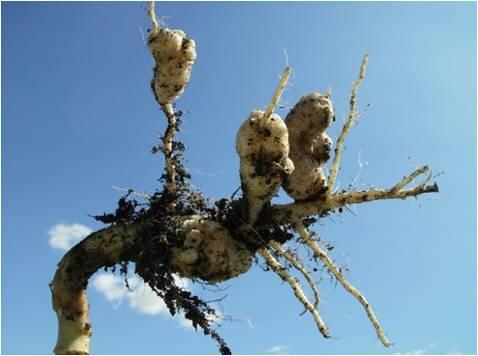
Take necessary steps to prevent soil run-off during rainfall. According to Ohio State University, certain fungicides may help to reduce development of clubroot disease. Your local Cooperative Extension Office can offer advice for your specific situation. Otherwise, there are no chemicals approved for clubroot treatment. Care for Plants with Clubroot If your garden soil is affected with clubroot, the only recourse is to pull and discard plants as soon as possible, as aggressive action is the only way to discourage spread of the disease.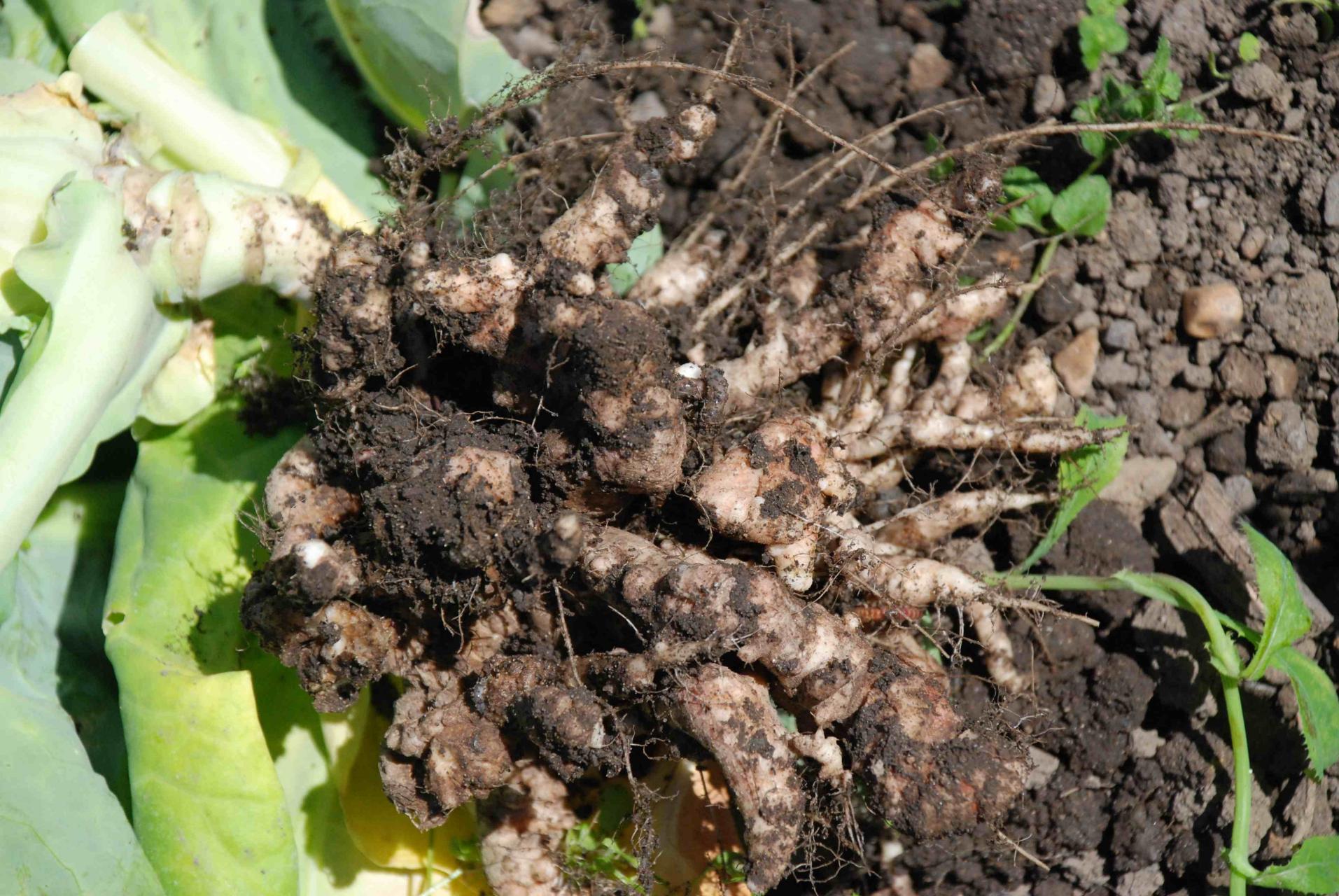
Dig around the plant and remove the entire root system to prevent the roots from breaking up and spreading the disease. Discard the plants properly and never put them on your compost pile. Next year, consider starting your own cruciferous plants from seed, using a sterile commercial potting soil. This is the best way to ensure you aren’t introducing the disease from an outside source. If you purchase seedlings, be sure to buy only plants that are guaranteed to be clubroot-free. Once again, be sure to rotate crops regularly.

Clubroot Control Clubroot is extremely difficult to manage and the best way to control its spread is to rotate crops, which means not planting cruciferous plants in the same area more than once every three or four years. Clubroot thrives in acidic soil, so raising the pH to at least 7.2 may be one of the most effective means of attaining clubroot control. Ohio State University Extension advises that calcitic lime is the best way to raise the pH, unless your soil is low in magnesium. In this case, dolomitic lime may be more effective. If possible, lime the soil at least six weeks before planting time. Be careful not to raise the pH too high, as highly alkaline soil may affect the growth of non-cruciferous plants. To prevent transmission of spores to uninfected areas, be sure to clean and disinfect garden tools and machinery after working in infected soil. Never invite trouble by moving infected plants or contaminated soil from one planting area to another (including the mud on the soles of your shoes).

Take necessary steps to prevent soil run-off during rainfall. According to Ohio State University, certain fungicides may help to reduce development of clubroot disease. Your local Cooperative Extension Office can offer advice for your specific situation. Otherwise, there are no chemicals approved for clubroot treatment. Care for Plants with Clubroot If your garden soil is affected with clubroot, the only recourse is to pull and discard plants as soon as possible, as aggressive action is the only way to discourage spread of the disease.

Dig around the plant and remove the entire root system to prevent the roots from breaking up and spreading the disease. Discard the plants properly and never put them on your compost pile. Next year, consider starting your own cruciferous plants from seed, using a sterile commercial potting soil. This is the best way to ensure you aren’t introducing the disease from an outside source. If you purchase seedlings, be sure to buy only plants that are guaranteed to be clubroot-free. Once again, be sure to rotate crops regularly.
0
0
文章
Dummer. ゛☀
2017年08月08日

Cytospora canker disease generally attacks spruces, especially Colorado blue and Norway varieties, as well as peach trees, Douglas firs or hemlock trees. What is cytospora canker? It is a destructive disease caused by the fungus Leucostoma kunzei that disfigures and can even kill vulnerable trees. Read on for more information about symptoms of cytospora canker as well as cytospora canker treatment.
What is Cytospora Canker? You may not have heard of cytospora canker until after a tree in your backyard is infected. If you notice that the lower limbs on your tree are dying, the tree might have cytospora canker disease. It attacks older trees, stressed trees and those with shallow roots or planted in inappropriate sites. One of the first symptoms of cytospora canker disease on spruce is the browning of needles on the tree’s lower limbs. When they fall, you may notice light patches of resin on the dead bark of the branches.
Over several years, symptoms of cytospora canker spread and upper branches brown and die. Dead areas of bark appear, known as cankers. On trees without needles, like peach trees, look for cankers on branches around pruning wounds. They may be present for several years, extending along the branch, before they kill it. Control of Cytospora Canker You may look to fungicidal sprays as a cytospora canker treatment, but these are not effective and are not recommended by experts. Instead, try using organic methods for control of cytospora canker. Prevention is easier than cytospora canker treatment. Take care not to wound trees susceptible to this disease. Wounds, like those from weed whackers and saws, serve as entry points for the fungus. Crowded trees are more likely to get and pass along the fungus. Plant yours with lots of room and good air circulation.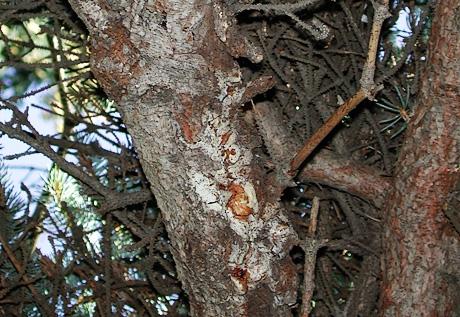
Take every precaution to keep the trees healthy and strong. Water them during dry periods and fertilize them annually to provide nutrients. Vigorous trees are less likely to get attacked. Prune out any infected branches and burn them, since the fungus overwinters in cankered bark. Use bleach to disinfect the pruners before and after each use. The best time for pruning is late winter or early spring in dry, sunny weather.

What is Cytospora Canker? You may not have heard of cytospora canker until after a tree in your backyard is infected. If you notice that the lower limbs on your tree are dying, the tree might have cytospora canker disease. It attacks older trees, stressed trees and those with shallow roots or planted in inappropriate sites. One of the first symptoms of cytospora canker disease on spruce is the browning of needles on the tree’s lower limbs. When they fall, you may notice light patches of resin on the dead bark of the branches.

Over several years, symptoms of cytospora canker spread and upper branches brown and die. Dead areas of bark appear, known as cankers. On trees without needles, like peach trees, look for cankers on branches around pruning wounds. They may be present for several years, extending along the branch, before they kill it. Control of Cytospora Canker You may look to fungicidal sprays as a cytospora canker treatment, but these are not effective and are not recommended by experts. Instead, try using organic methods for control of cytospora canker. Prevention is easier than cytospora canker treatment. Take care not to wound trees susceptible to this disease. Wounds, like those from weed whackers and saws, serve as entry points for the fungus. Crowded trees are more likely to get and pass along the fungus. Plant yours with lots of room and good air circulation.

Take every precaution to keep the trees healthy and strong. Water them during dry periods and fertilize them annually to provide nutrients. Vigorous trees are less likely to get attacked. Prune out any infected branches and burn them, since the fungus overwinters in cankered bark. Use bleach to disinfect the pruners before and after each use. The best time for pruning is late winter or early spring in dry, sunny weather.
0
0
文章
Dummer. ゛☀
2017年08月07日

Cedar hawthorn rust is a serious disease of hawthorn and juniper trees. There is no cure for the disease, but you can prevent its spread. Find out how to control cedar hawthorn rust in this article. What is Cedar Hawthorn Rust? Caused by a fungus called Gymnosporangium globosum, Cedar hawthorn rust disease is a disfiguring condition of hawthornsand junipers. Although it rarely kills trees, the trees never recover from the damage. You can prune out the worst of it, but once it affects the entire tree, your only choices are to learn to live with it or take the tree down. 
In addition to the rust-colored spots on the leaves, hawthorns may have rusty-looking “fingers” projecting from the fruit. The leaves may yellow and drop from the tree. Junipers develop woody galls that also have rusty fingers. If you recognize and treat the disease early, you may be able to enjoy your tree for several more years.

Cedar Hawthorn Rust Treatment When a tree has visible symptoms of cedar hawthorn rust, it is too late to save the tree. Focus on slowing its progress and preventing it from spreading to other trees in the surrounding area. The fungal spores that infect additional trees are blown about on the wind, so most new infections occur within a few hundred feet of an infected tree. That said, spores have been known to travel a few miles. It’s best to err on the side of caution when deciding whether or not to use preventative treatment on a tree. The two-part life cycle of cedar hawthorn rust disease involves both hawthorns and junipers. Infected hawthorns develop reddish-brown spots (rust) on the leaves and junipers have galls with fingers extending from them. Remove the galls in winter to help prevent spread and never plant junipers near hawthorns.
Although you can’t cure an infected tree, you can prune out infected parts of the tree to improve its health and appearance. Remove entire branches wherever possible. This not only benefits the infected tree, but also reduces the number of spores capable of spreading the infection. Moisture around hawthorn and juniper trees encourages the fungus. Reduce moisture by making sure air circulates freely around the tree. You may be able to accomplish this through pruning. When watering the tree, direct the spray toward the soil rather than the branches. Protect trees from infection by spraying in spring and early summer with an approved fungicide. Both chlorothalonil and mancozeb are registered for use against cedar rust disease on hawthorns. Follow the label instructions and spray the tree until the fungicide drips from the branches. Spray junipers with a Bordeaux mixture every two weeks beginning in midsummer.

In addition to the rust-colored spots on the leaves, hawthorns may have rusty-looking “fingers” projecting from the fruit. The leaves may yellow and drop from the tree. Junipers develop woody galls that also have rusty fingers. If you recognize and treat the disease early, you may be able to enjoy your tree for several more years.

Cedar Hawthorn Rust Treatment When a tree has visible symptoms of cedar hawthorn rust, it is too late to save the tree. Focus on slowing its progress and preventing it from spreading to other trees in the surrounding area. The fungal spores that infect additional trees are blown about on the wind, so most new infections occur within a few hundred feet of an infected tree. That said, spores have been known to travel a few miles. It’s best to err on the side of caution when deciding whether or not to use preventative treatment on a tree. The two-part life cycle of cedar hawthorn rust disease involves both hawthorns and junipers. Infected hawthorns develop reddish-brown spots (rust) on the leaves and junipers have galls with fingers extending from them. Remove the galls in winter to help prevent spread and never plant junipers near hawthorns.

Although you can’t cure an infected tree, you can prune out infected parts of the tree to improve its health and appearance. Remove entire branches wherever possible. This not only benefits the infected tree, but also reduces the number of spores capable of spreading the infection. Moisture around hawthorn and juniper trees encourages the fungus. Reduce moisture by making sure air circulates freely around the tree. You may be able to accomplish this through pruning. When watering the tree, direct the spray toward the soil rather than the branches. Protect trees from infection by spraying in spring and early summer with an approved fungicide. Both chlorothalonil and mancozeb are registered for use against cedar rust disease on hawthorns. Follow the label instructions and spray the tree until the fungicide drips from the branches. Spray junipers with a Bordeaux mixture every two weeks beginning in midsummer.
0
0
文章
Dummer. ゛☀
2017年08月07日

Fungus happens. Even the most experienced and dedicated gardeners will experience fungal disease on plants at some point. Fungus can affect plants in any climate and hardiness zone because, like plants, certain fungal spores grow better in different climates.
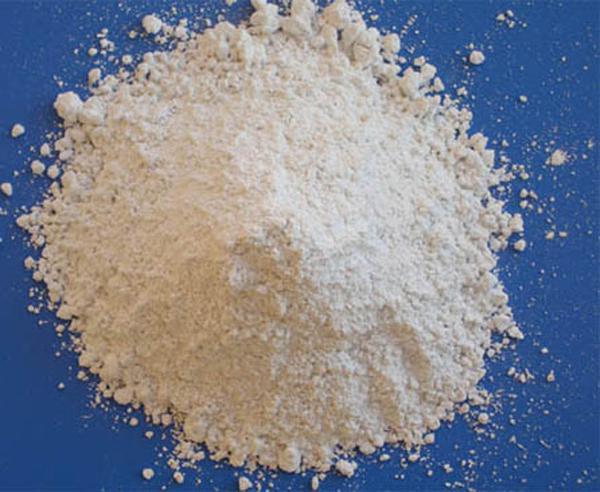
Even new disease resistant varieties can suffer from these issues. As gardeners, we can choose to spend a fortune on different chemicals that can have residual effects to treat different symptoms or we can use a natural based product that has been used by growers and breeders for hundreds of years.

What is Lime Sulfur? Lime sulfur is a mixture of calcium hydroxide and sulfur. In horticultural dormant sprays, lime sulfur is usually mixed with an oil, like mineral oil, to make it stick to plant surfaces. These horticultural oil sprays contain a high concentration of lime sulfur that is only safe to use on plants that are dormant because the sulfur can burn leaf tissues. Lime sulfur can also be mixed in much weaker concentration with water for use when plants have leafed out. Even in lower concentrations and diluted with water, it is important not to spray lime sulfur on plants during hot, sunny days, as the sulfur can cause sunscald on plants. With warnings like this, you may wonder is lime sulfur safe? When used properly, lime sulfur is a safe and effective treatment of fungal diseases such as: Powdery mildew Anthracnose Black spot Blights Black rot As a horticultural dormant spray, lime sulfur is safe to use even on fruits that include: Raspberries Blackberries Blueberries Apples Peaches Pears Plums Cherries Lime sulfur is also used to treat fungal diseases of ornamental plants like: Roses Dogwoods Ninebark Phlox Rudbeckia.

How and to Use Lime Sulfur Fungal disease spores can overwinter in cracks or fissures on plants or in soil and garden debris. For this reason, lime sulfur is used in high concentrates mixed with oil as a horticultural dormant spray. When to use lime sulfur this way is in late winter or early spring before the plant begins to leaf out. It is also a good idea to spray the soil around plants that have been previously infected or are prone to infection. For perennials or plants that are showing new signs of fungal diseases, lime sulfur can be mixed with water and sprayed on plants anytime except for hot, sunny days. The mixing ratio is 1 tsp. per gallon of water. Spray all surfaces of the plant thoroughly. Allow the mixture to sit on the plants for 15-20 minutes. Then thoroughly rinse the plants with just clear water. Occasionally, you will notice the bottom portion of tree trunks covered with white latex paint. Sometimes, this contains a diluted mixture of lime sulfur.

Even new disease resistant varieties can suffer from these issues. As gardeners, we can choose to spend a fortune on different chemicals that can have residual effects to treat different symptoms or we can use a natural based product that has been used by growers and breeders for hundreds of years.

What is Lime Sulfur? Lime sulfur is a mixture of calcium hydroxide and sulfur. In horticultural dormant sprays, lime sulfur is usually mixed with an oil, like mineral oil, to make it stick to plant surfaces. These horticultural oil sprays contain a high concentration of lime sulfur that is only safe to use on plants that are dormant because the sulfur can burn leaf tissues. Lime sulfur can also be mixed in much weaker concentration with water for use when plants have leafed out. Even in lower concentrations and diluted with water, it is important not to spray lime sulfur on plants during hot, sunny days, as the sulfur can cause sunscald on plants. With warnings like this, you may wonder is lime sulfur safe? When used properly, lime sulfur is a safe and effective treatment of fungal diseases such as: Powdery mildew Anthracnose Black spot Blights Black rot As a horticultural dormant spray, lime sulfur is safe to use even on fruits that include: Raspberries Blackberries Blueberries Apples Peaches Pears Plums Cherries Lime sulfur is also used to treat fungal diseases of ornamental plants like: Roses Dogwoods Ninebark Phlox Rudbeckia.

How and to Use Lime Sulfur Fungal disease spores can overwinter in cracks or fissures on plants or in soil and garden debris. For this reason, lime sulfur is used in high concentrates mixed with oil as a horticultural dormant spray. When to use lime sulfur this way is in late winter or early spring before the plant begins to leaf out. It is also a good idea to spray the soil around plants that have been previously infected or are prone to infection. For perennials or plants that are showing new signs of fungal diseases, lime sulfur can be mixed with water and sprayed on plants anytime except for hot, sunny days. The mixing ratio is 1 tsp. per gallon of water. Spray all surfaces of the plant thoroughly. Allow the mixture to sit on the plants for 15-20 minutes. Then thoroughly rinse the plants with just clear water. Occasionally, you will notice the bottom portion of tree trunks covered with white latex paint. Sometimes, this contains a diluted mixture of lime sulfur.
0
0
Ueca
2017年07月09日

What do you think about lichens (地衣)? Are they useful? Are they pests? Should I keep them around?
Lichens are a combination of fungus and algae. They are self-sufficient and occupy spaces that are not used by other plants. They seem to respond poorly to acute conditional changes, and will die out if something is not right, similar to moss.


Lichens are a combination of fungus and algae. They are self-sufficient and occupy spaces that are not used by other plants. They seem to respond poorly to acute conditional changes, and will die out if something is not right, similar to moss.


0
0
文章
Hande Salcan
2017年02月21日

Of all the plant pathogens, the ones you will deal with mostly are fungi. All plants are susceptible to attack from fungus. Most #fungi love wet conditions, and overwatering can produce such conditions.

If the soil your plant is rooted in does not drain well, and water stands too long at the base and around the roots, then your #plant is at risk of developing water mold root rot, a condition that is caused by a variety of fungi. The fungi start a rot that invades the roots and then works its way up the plant. This can be a quick or a slow process, depending on conditions. Often, after the rot is established, you will see dark discolorations in the plant’s roots and stems. This is where the infected plant tissue meets the healthy tissue.
The following is a list of potential problems and common symptoms caused by fungal diseases.
Damping-off: This disease can kill seedlings before they even break through the soil, but it also strikes seedlings just an inch or so tall.
Root Rot: This generally attacks older plants, killing the tiny rootlets and appearing above ground as stunting and wilting.
Club Root: This disease commonly infects cabbage family plants, causing large swellings on roots and or dead plants.
Blights: Includes early and late blight, which attack tomatoes and their relatives. The fungi can damage or kill leaves and cause rot in the fruit.
Mildews: This would include downy and powdery mildew. Infection results in spots or white patches on leaves, shoots, and other plant parts. Downy mildew can kill plants rapidly; powdery mildew commonly causes poor growth and lower yield, but seldom kills the plant.
Rusts: This disease will produce orange and white spots, usually on leaves and stems, weakening plants and reducing crop yields.
Leaf Spot: These symptoms are caused by a wide range of fungi.
How to Minimize Fungal Problems
Fungi spread by spore production, giving the disease the ability to travel great distances. The spores can be picked up by animals or water, including gardeners! One of the best ways to prevent fungal problems is to select plants that are resistant to the fungal diseases in your area.
After treating plants with fungal problems, rinse your gardening tools with alcohol or bleach, in case any spores remain, and destroy any diseased leaves rather than leaving them on the ground or placing them in your composting bin.
Organic Fungus-Killing Sprays

Instead of treating areas with chemical powders, you can use organic fungicides made straight from products in your kichen. Here is a list of some safe and easy to make sprays:
Basic Soda Spray
2 Tablespoons baking soda
1 gallon water
Add 1 teaspoon of vegetable oil (adds stickiness)
Mix all together and spray on problem areas.
Soda Spray for Rust
2 tablespoons baking soda
1 gallon water
6 tablespoons of vegetable oil
2 tablespoons kelp extract
Mix together and spray rust-covered areas.
Garlic is known to fight many types of disease-causing fungi, including mildew, mold, and rust. Garlic has not only shown that it can fight fungi but it also has some repellant qualities for other diseases and insects.
Basic Garlic Spray
1 garlic bulb
1 quart water
Crush the garlic and place in a pan of water, bring to a boil, then turn off heat. Let the mixture cool. Strain out the garlic.
Pour liquid into a spray bottle and spray the infected areas of the plant.
Vinegar Spray
Apple cider vinegar makes a great spray to combat many fungal diseases, including black spot on roses.
3 tablespoons apple cider vinegar
1 gallon water.
Mix together. Spray plants, being sure to do so in the morning so that the plant can dry out before evening.
Nothing spoils the look of a plant or shrub more than a fungus disease. Hopefully, by using some of the methods described in this article, you will be able to keep your plants looking healthy!

If the soil your plant is rooted in does not drain well, and water stands too long at the base and around the roots, then your #plant is at risk of developing water mold root rot, a condition that is caused by a variety of fungi. The fungi start a rot that invades the roots and then works its way up the plant. This can be a quick or a slow process, depending on conditions. Often, after the rot is established, you will see dark discolorations in the plant’s roots and stems. This is where the infected plant tissue meets the healthy tissue.
The following is a list of potential problems and common symptoms caused by fungal diseases.
Damping-off: This disease can kill seedlings before they even break through the soil, but it also strikes seedlings just an inch or so tall.
Root Rot: This generally attacks older plants, killing the tiny rootlets and appearing above ground as stunting and wilting.
Club Root: This disease commonly infects cabbage family plants, causing large swellings on roots and or dead plants.
Blights: Includes early and late blight, which attack tomatoes and their relatives. The fungi can damage or kill leaves and cause rot in the fruit.
Mildews: This would include downy and powdery mildew. Infection results in spots or white patches on leaves, shoots, and other plant parts. Downy mildew can kill plants rapidly; powdery mildew commonly causes poor growth and lower yield, but seldom kills the plant.
Rusts: This disease will produce orange and white spots, usually on leaves and stems, weakening plants and reducing crop yields.
Leaf Spot: These symptoms are caused by a wide range of fungi.
How to Minimize Fungal Problems
Fungi spread by spore production, giving the disease the ability to travel great distances. The spores can be picked up by animals or water, including gardeners! One of the best ways to prevent fungal problems is to select plants that are resistant to the fungal diseases in your area.
After treating plants with fungal problems, rinse your gardening tools with alcohol or bleach, in case any spores remain, and destroy any diseased leaves rather than leaving them on the ground or placing them in your composting bin.
Organic Fungus-Killing Sprays

Instead of treating areas with chemical powders, you can use organic fungicides made straight from products in your kichen. Here is a list of some safe and easy to make sprays:
Basic Soda Spray
2 Tablespoons baking soda
1 gallon water
Add 1 teaspoon of vegetable oil (adds stickiness)
Mix all together and spray on problem areas.
Soda Spray for Rust
2 tablespoons baking soda
1 gallon water
6 tablespoons of vegetable oil
2 tablespoons kelp extract
Mix together and spray rust-covered areas.
Garlic is known to fight many types of disease-causing fungi, including mildew, mold, and rust. Garlic has not only shown that it can fight fungi but it also has some repellant qualities for other diseases and insects.
Basic Garlic Spray
1 garlic bulb
1 quart water
Crush the garlic and place in a pan of water, bring to a boil, then turn off heat. Let the mixture cool. Strain out the garlic.
Pour liquid into a spray bottle and spray the infected areas of the plant.
Vinegar Spray
Apple cider vinegar makes a great spray to combat many fungal diseases, including black spot on roses.
3 tablespoons apple cider vinegar
1 gallon water.
Mix together. Spray plants, being sure to do so in the morning so that the plant can dry out before evening.
Nothing spoils the look of a plant or shrub more than a fungus disease. Hopefully, by using some of the methods described in this article, you will be able to keep your plants looking healthy!
1
0




